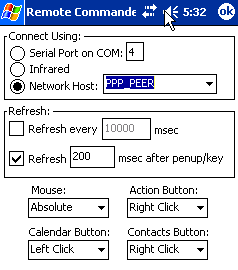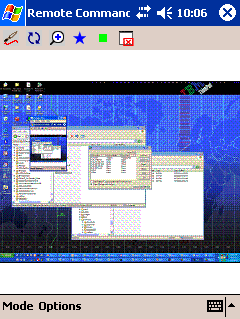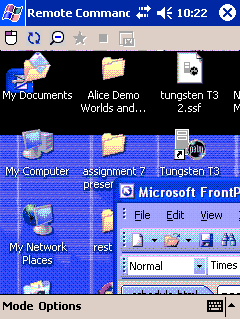Remote Commander for the Windows CE / Pocket PC
Revised for Version 6.1

Running Remote Commander
To run Remote Commander:
- Start PebblesPC on the host computer.
- Connect the handheld to the PC: Use a network connection,
the cradle, etc. See discussion of connecting, especially using Networks
or ActiveSync.
- Run RemoteCommander on the handheld device: Click on the
RemoteCommander on the PocketPC's Start Menu. After starting Remote Commander
you should hear a tone from the device indicating that it has connected to PebblesPC. PebblesPC should display
"Grabber", "RemoteControl" or "Scribble" next to the
COM port or network IP number.
- You can now use Remote Commander to control your PC!
Seeing PC Screen on the PocketPC Screen
Remote Commander version 6.1 for PocketPC can capture the screen of the PC and
show it on the PocketPC screen.
The picture can be refreshed periodically, for example, every 2000 msec
(every 2 seconds), with the refresh rate set in the Options dialog box (described
below). Clicking on the refresh icon at the top of the PocketPC screen (the
blue arrows, second from the left) will refresh immediately. The picture above
left
shows the full PC screen on the PocketPC screen. If you hit the zoom icon (the
magnifying glass with the "+" in it, third from left), then you can
zoom in, so you can see the PC screen at a one-to-one ratio (one pixel on the
PC screen to one pixel on the handheld, as shown above right). To zoom out again, hit the magnifying
glass with the "-" sign in it.
When zoomed it, you can scroll around using the PocketPC's arrow keys (for
example, the iPaq's rocker switch).
Controlling the Mouse
Remote Commander emulates a pointing device and keyboard for the desktop PC.
There are various options that control how this works. The left-most menu at
the bottom ("Mode")
has two options:
- Remote Commander: In this mode, the PocketPC emulates the
real mouse and keyboard of the PC. This means that moving the stylus on the
PocketPC will move the real cursor on the PC, and tapping will pretend to
press the mouse button.
- Scribble: In this mode, each PocketPC gets its own independent
"pretend" cursor on the PC, so you can annotate and point at things
using the PocketPC without changing where the real cursor is. See also the
description of the Palm Scribble program.
The users can draw ephemeral "scribbles" on the screen. A fake cursor
is controlled by the user, which allows more than one PDA to scribble on a
PC screen at one time. The shape and color of the user's PC cursor can be
changed by using the fourth and fifth toolbar buttons. You can erase all the
scribbles using the last toolbar icon ("Erase Scribbles").
Another set of options (set on the Options dialog, see below) determines whether
the cursor works in Relative or Absolute mode.
- Absolute: By default, putting the stylus on the picture
on the PocketPC screen will move the cursor to the corresponding point on
the PC screen. Thus, putting the stylus on the left of the screen will put
the PC cursor on the left of the PC's screen.
- Relative: If you change the mode to Relative, then the
particular position of the stylus on the screen is ignored, and only movements
are relevant. This is like how a mouse or touchpad works.
Another option controls what happens when the stylus touches the PocketPC screen.
The icon on the top-left that is supposed to look like a mouse or a pen controls this.
The options change depending on whether you are in Remote Commander or
Scribble mode.
 For
Scribble:
For
Scribble:
- The "blank" mouse (top icon) means that
whenever the stylus touches the PocketPC screen, the stylus moves
the cursor on the PC, but doesn't press the mouse buttons. To draw on the
screen, press in on the "action" physical button in the center-bottom of the
PocketPC.
- The "scribble" icon at the bottom means
that whenever the stylus touches the PocketPC screen, Scribble will draw on
the screen.
 For
Remote Commander:
For
Remote Commander:
- The "blank" mouse means that
whenever the stylus touches the PocketPC screen, the stylus moves the cursor
on the PC, but doesn't press the mouse buttons. To draw on the screen, press
in on the "action" physical button in the center-bottom of the PocketPC.
- The icon with the red area on the left means that whenever the stylus
touches the PocketPC screen, RemoteCommander will tell the PC that the left
mouse button is down. This makes it much easier to interact with the PC, but
makes it important to touch in exactly the right place.
- The icon with the red area on the right means that whenever the stylus
touches the PocketPC screen, RemoteCommander will tell the PC that the right
mouse button is down.
Pressing the Action Button on the PocketPC will also press
the mouse button, no matter what modes are set. Holding down the Action
button can be used to drag objects. The Option menu control whether the action
button mimics the Left or Right mouse buttons.
The Calendar and Contacts hard (physical) buttons on the PocketPC can also be
assigned to perform left or right mouse button actions. By default, Calendar is
left and Contacts is assigned to Right Click.
Controlling the Keyboard
 Remote
Commander also emulates the PC's keyboard. Any keys typed into the input area
are sent to the PC. This works from the pop-up keyboard (see right), the Character
Recognizer, or even using Transcriber (the handwriting recognition). In order
to support all the PC's special keys, RemoteCommander adds three lines above
the regular pop-up keyboard (see right). These three lines will appear no matter
what input technique is used. The extra lines also include the "Alt"
modifier for the other keys.
Remote
Commander also emulates the PC's keyboard. Any keys typed into the input area
are sent to the PC. This works from the pop-up keyboard (see right), the Character
Recognizer, or even using Transcriber (the handwriting recognition). In order
to support all the PC's special keys, RemoteCommander adds three lines above
the regular pop-up keyboard (see right). These three lines will appear no matter
what input technique is used. The extra lines also include the "Alt"
modifier for the other keys.
On HPC Windows CE devices (with a keyboard), typing on the built in keyboard,
or using the handwriting recognition software, will send characters to the PC.
Summary of Toolbar and Menu Items
Toolbar

- Mouse: controls whether pressing on the PocketPC with the
stylus causes the PC's mouse button to be pressed (to draw or emulate the
left or right mouse buttons).
- Refresh: redraws the handheld screen with a new picture
from the PC.
- Magnifying glass: zoom in or out the PC screen view on
the PocketPC.
-

 Shape: controls the shape of the cursor on the PC when
using Scribble.
Shape: controls the shape of the cursor on the PC when
using Scribble.
-
Pen color: controls the color of the drawing on the PC
when using Scribble.
- Erase Scribbles: Available when in Scribble mode.
Menus
- Mode / Remote Commander: control the real PC cursor.
- Mode / Scribble: control a pretend user-specific cursor
on the PC.
- Options / Options... : pops up the options dialog (see
below)
- Options / About... : Shows the version of Remote Commander
Options
 The
top of the options dialog box controls the connection to the PC. See the discussion
about connections. The network fill-in
field will remember the last few IP addresses used.
The
top of the options dialog box controls the connection to the PC. See the discussion
about connections. The network fill-in
field will remember the last few IP addresses used.
The option to Refresh every ____ msec controls whether the picture is automatically
downloaded from the PC that often. Checking this may seem to cause the PocketPC
to lock-up, because it cannot handled user input while it is downloading the
picture.
The option to Refresh ____ msec after penup or a keystroke gets a new picture
from the PC after a stroke or after you send a key. The delay (here 200 msec)
allows you to draw multiple strokes or hit multiple keys, and then only retrieve
the new picture when it seems like you are finished.
The Mouse options are Absolute and Relative as described above in controlling
the mouse section.
The Action Button options are Left Click and Right Click. The Calendar Button
controls the physical Calendar button's actions. The options are Left Click and
Right Click, but also Calendar, which returns the button to its normal function.
Similarly, for the Contacts Button.




 Remote
Commander also emulates the PC's keyboard. Any keys typed into the input area
are sent to the PC. This works from the pop-up keyboard (see right), the Character
Recognizer, or even using Transcriber (the handwriting recognition). In order
to support all the PC's special keys, RemoteCommander adds three lines above
the regular pop-up keyboard (see right). These three lines will appear no matter
what input technique is used. The extra lines also include the "Alt"
modifier for the other keys.
Remote
Commander also emulates the PC's keyboard. Any keys typed into the input area
are sent to the PC. This works from the pop-up keyboard (see right), the Character
Recognizer, or even using Transcriber (the handwriting recognition). In order
to support all the PC's special keys, RemoteCommander adds three lines above
the regular pop-up keyboard (see right). These three lines will appear no matter
what input technique is used. The extra lines also include the "Alt"
modifier for the other keys. The
top of the options dialog box controls the connection to the PC. See the discussion
about
The
top of the options dialog box controls the connection to the PC. See the discussion
about